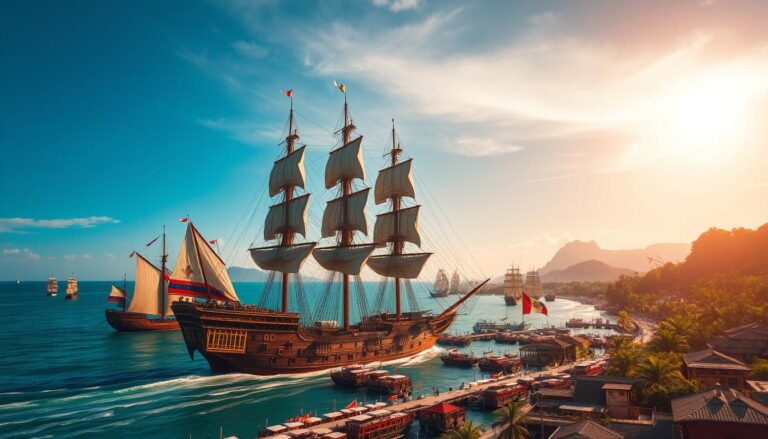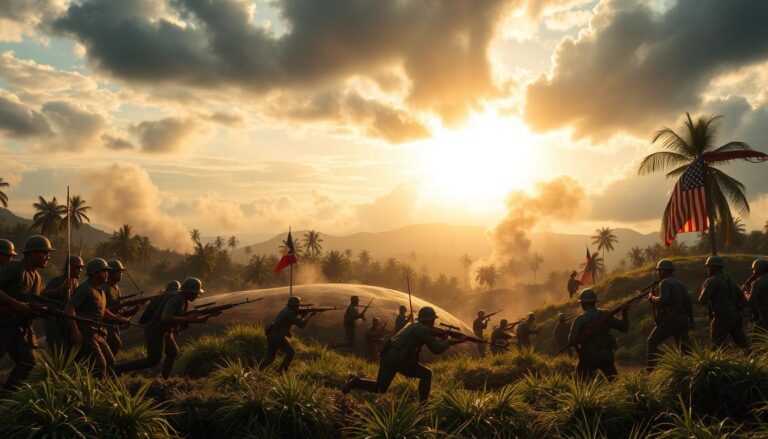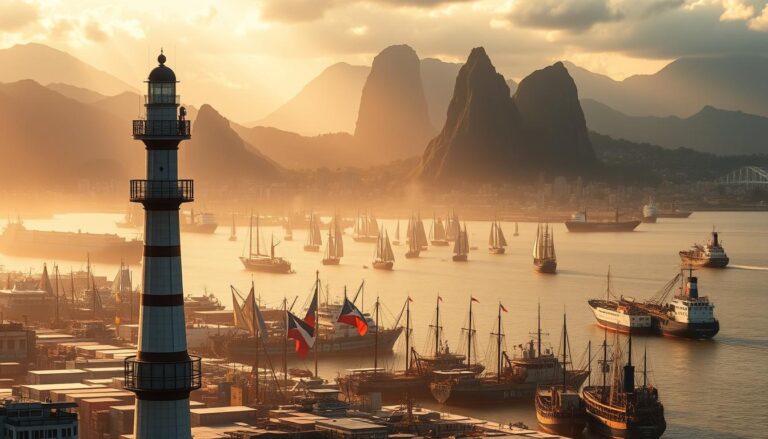Manila Massacre Survivors: Untold Stories of WWII Horror

If you explore Manila Massacre survivors’ accounts, you’ll witness WWII’s raw brutality through the eyes of ordinary families caught in siege and chaos. You’ll see how shelling, desperate searches for sanctuary, and forced separations tore communities apart, leaving up to 100,000 civilians dead.
Firsthand stories reveal everyday acts of courage, ongoing trauma, and the fortitude that shaped generations.
Highlights
- Survivors recount harrowing escapes from Japanese violence, often witnessing family members killed or separated during the chaos.
- Many found temporary refuge in places like the Philippine General Hospital, one of the few safe havens amid relentless attacks.
- Firsthand testimonies describe the trauma of starvation, injury, and witnessing massacres, including the notorious Dy Pac lumber yard atrocity.
- Acts of bravery emerged as neighbors and strangers risked their lives to shelter or rescue others during the urban siege.
- The psychological scars and grief from the massacre still affect survivors and their descendants, shaping collective memory and community identity.
Manila Massacre Survivors: Untold Stories of WWII Horror |A Summary
| Section | Key Points |
|---|---|
| Overview | • Documented accounts of ordinary families during WWII’s Manila Massacre • Up to 100,000 civilians killed during shelling, chaos, and violence • Stories reveal everyday courage, trauma, and generational impact • Also known as the “Rape of Manila,” paralleling the “Rape of Nanking” • One of the largest civilian massacres of the Pacific War |
| Historical Context | • Manila was declared an “Open City” in December 1941 to prevent destruction • Japanese occupation lasted from January 1942 to February 1945 • General Douglas MacArthur promised “I shall return” when evacuating in 1942 • Admiral Sanji Iwabuchi defied orders to withdraw, choosing to make a last stand • Japanese Navy’s “Manila Naval Defense Force” primarily responsible for atrocities |
| The Siege of Manila | • February 3 – March 3, 1945 • Japanese troops unleashed systematic violence as American forces advanced • Approximately 100,000 civilians perished • Notable incidents like Dy Pac lumber yard massacre • Left Manila as one of Pacific War’s most devastated urban landscapes • Battle resulted in 85% destruction of the historic Intramuros district • Japanese forces destroyed bridges and infrastructure during their defense |
| Specific Atrocities | • Massacre at De La Salle College claimed 41 refugees including women and children • German Club massacre where 400 civilians were killed • St. Paul’s College incident where women were assaulted and killed • Manila Cathedral was used as mass execution site • Red Cross personnel were specifically targeted at various locations • Bayonet and samurai sword executions were common methods used |
| Firsthand Accounts | • Civilians caught between intense shelling and Japanese troops • Finding refuge was matter of life and death • Philippine General Hospital became rare sanctuary • Survivors documented by groups like Memorare-Manila 1945 • Carmen Guerrero Nakpil wrote famous memoir “Myself, Elsewhere” about her experiences • Many foreigners including Europeans and Americans were targeted for execution |
| Loss and Separation | • Families torn apart during frantic search for safety • Japanese troops triggered widespread separation • Generational emotional wounds persist • Notable accounts from survivors like Vicky Quirino-Delgado and Jim Litton • Many orphaned children formed new “street families” to survive • Specific targeting of Chinese-Filipino families, with estimated 2,500 killed |
| Acts of Resistance | • Civilians hiding, scavenging for food, seeking shelter • Individuals risked lives to save family and neighbors • Example: Father Paul de Guzman’s sanctuary in Tondo Church • Community support networks formed amid destruction • Underground resistance groups smuggled food and medicine • Clandestine radio operators maintained contact with Allied forces • Some Filipinos created fake Japanese passes to move through the city |
| Haunting Memories | • Persistent psychological scars and grief • Survivors still recount vivid memories of violence • Organizations document memories to preserve history • Trauma continues to shape community identity • Post-Traumatic Stress Disorder widely documented but untreated for decades • Annual February 3rd remembrance ceremonies at Memorare-Manila Monument |
| Legal Aftermath | • General Yamashita’s trial established “command responsibility” doctrine • US Supreme Court upheld conviction in controversial 6-2 decision • Yamashita executed February 23, 1946 despite not directly ordering atrocities • Rear Admiral Sanji Iwabuchi committed suicide rather than surrender • Tokyo War Crimes Tribunal largely overlooked Manila Massacre compared to other atrocities |
| Cultural Impact | • Destruction of historical Spanish colonial architecture forever changed Manila • Pre-war cultural collections including national archives were lost • Manila’s status as “Pearl of the Orient” never fully recovered • Post-war reconstruction prioritized function over historical preservation • Trauma influenced Filipino-Japanese relations for generations |
| Preserving Legacy | • Survivors breaking silence to document testimonies • Organizations like Memorare-Manila 1945 anchor public remembrance • Education and dialogue serve as vehicles for reconciliation • Efforts focus on preventing history’s repetition • Intramuros Administration preserves ruins as physical reminders • 2014 documentary “Manila: In the Claws of Light” brought renewed attention • Japanese government’s 1999 official expression of “deep remorse” and “heartfelt apology” |
The Siege of Manila: A City Under Fire
Although the end of World War II marked liberation for many in the Philippines, the Siege of Manila from February 3 to March 3, 1945, became a devastating chapter in the city’s history. As American troops advanced to reclaim Manila, Japanese troops entrenched themselves, releasing systematic violence on civilians inside.
The city’s streets became battlegrounds, where artillery fire and mass executions contributed to a staggering death toll, approximately 100,000 civilians perished. Notable incidents, such as the massacre at Dy Pac lumber yard, underscored the brutality civilians faced. The Siege of Manila left the city’s infrastructure in ruins, transforming it into one of the Pacific War’s most shattered urban landscapes.
This tragic episode highlights the immense human cost when freedom is contested in urban warfare. The battle was characterized by intense urban warfare challenges that complicated efforts to protect civilians while engaging entrenched Japanese forces.
Firsthand Accounts: Surviving the Chaos
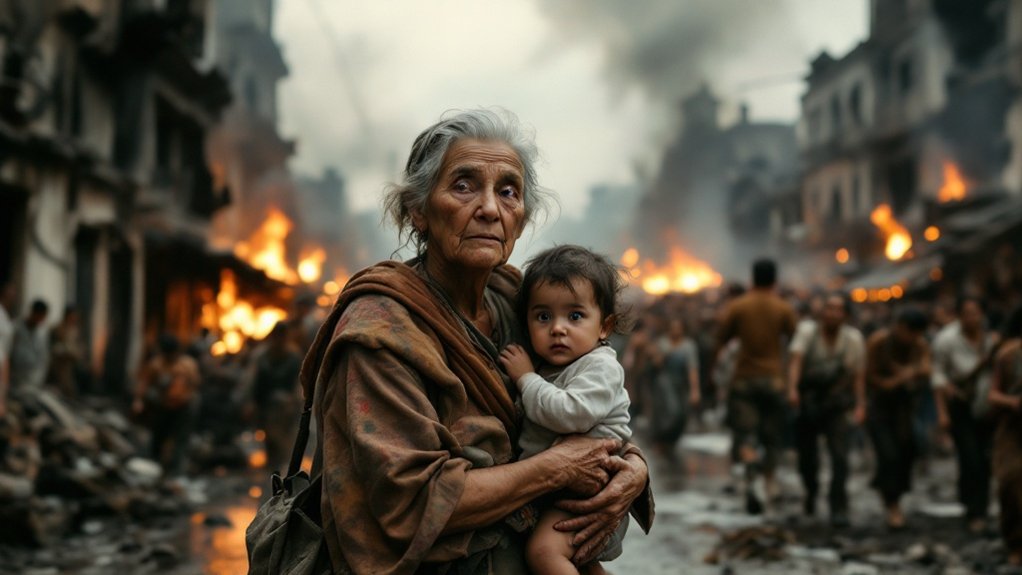
While the Siege of Manila raged, survivors’ testimonies illuminate the ordeal civilians faced as violence engulfed the city. During the battle of Manila, you’d have found yourself caught between intense shelling and the relentless advance of Japanese troops. Firsthand accounts reveal that finding any refuge was a matter of life or death some, like Vicky Quirino-Delgado, recounted losing loved ones to brutal attacks, while others, such as Jim Litton, described desperate flights from danger.
The Philippine General Hospital became a rare sanctuary amid chaos, though safety was never guaranteed. Survivors’ stories, documented by groups like Memorare-Manila 1945, serve as essential reminders of fortitude and the human cost of war.
Survivors’ voices reveal the desperate search for refuge as Manila was torn apart by violence and the horrors of war.
- Scavenging for water under fire
- Hiding from Japanese troops
- Seeking refuge in hospitals
- Witnessing atrocities firsthand
Loss and Separation: Families Torn Apart
Amid the chaos of the Manila Massacre, families were often separated in the frantic search for safety, leaving lasting emotional wounds that persist across generations. Japanese troops sweeping through the city triggered widespread loss and separation, with countless families torn apart during violent evacuations and assaults.
The estimated 100,000 civilian deaths not just decimated communities but also shattered the fabric of family life, as seen in the story of Vicky Quirino-Delgado, who lost her mother and sister. Survivors like Jim Litton have described the enduring trauma of witnessing loved ones disappear or die amid the violence.
Acts of Resistance and Courage

Despite the overwhelming terror released during the Battle of Manila, acts of resistance and courage emerged as defining features of civilian survival. You’d witness civilians hiding from Japanese soldiers, scavenging for food, and taking shelter in churches and hospitals, each action a demonstration of the will for freedom.
Survivor accounts highlight individuals risking their lives to save family and neighbors or to support strangers at the height of chaos. These acts of resistance weren’t just spontaneous; they reflected a collective courage among survivors enduring brutality and destruction.
Father Paul de Guzman’s sanctuary in Tondo Church and community support networks illustrate how courage persisted, even as the city fell apart.
In the face of terror, Manila’s civilians showed remarkable courage, risking everything to protect one another and uphold their will to survive.
- Hiding from Japanese soldiers in makeshift shelters
- Scavenging for food and water under threat
- Shelter and protection in churches and hospitals
- Neighbors risking all to save others
Haunting Memories: The Aftermath of Atrocity
Even as the guns fell silent after the Battle of Manila, the city’s survivors faced a different kind of struggle, one marked by persistent psychological scars and unrelenting grief. You’d find trauma shaping every memory of civilians who endured the atrocities: vivid recollections of starvation, separation, and relentless violence.
Decades later, survivors still recount the loss of family and the destruction of entire communities. Organizations like Memorare-Manila 1945 have worked to document these memories, ensuring the pain and fortitude of those affected aren’t erased. The generational impact is profound; trauma lingers within families, shaping identity and collective memory. This table summarizes key aspects:
| Aspect | Description |
|---|---|
| Survivors | Continue to share experiences |
| Trauma | Persists across generations |
| Civilians | Experienced widespread loss |
| Atrocities | Included massacres, starvation, brutality |
| Memories | Central to community identity and healing |
10 not so well-known and surprising facts about Manila Massacre survivors
- 🏛️ Some survivors of the Manila Massacre established memorial organizations that remained active for decades but operated with minimal public recognition, creating detailed archives that only recently have been digitized for historical preservation.
- 🗣️ Several survivors developed a unique form of coded language among themselves, using subtle hand gestures and phrases that referenced locations in pre-war Manila, allowing them to identify fellow survivors in public settings.
- 🩺 A group of Filipino medical students who survived the massacre went on to pioneer trauma psychology techniques in the Philippines, developing therapeutic approaches specifically for massacre survivors decades before PTSD was widely recognized.
- 📝 Some survivors kept meticulous daily diaries during Japanese occupation, hiding them in hollowed-out furniture and wall spaces; these accounts have provided historians with hour-by-hour documentation of events often missing from official records.
- 🌱 A survivor-led urban garden initiative began in the 1950s that transformed several massacre sites into memorial gardens, with plants specifically chosen to bloom during February, the anniversary month of the massacre.
- 👨👩👧👦 A study in the 1980s discovered that children of survivors showed distinct psychological resilience patterns compared to their peers, with researchers identifying specific parenting approaches that emerged from the trauma experience.
- 🏫 A network of informal schools was established by survivors after the war, where they taught pre-war cultural traditions and practices that were at risk of being lost, creating cultural continuity despite the destruction.
- 🎭 Several survivors became renowned playwrights who incorporated their experiences into theatrical works that used metaphor and allegory rather than direct references, creating a unique artistic response to trauma that influenced Filipino theater.
- 📻 A clandestine radio network operated by survivors after the war helped reunite separated families, with broadcasts using coded messages that only those familiar with specific Manila neighborhoods would understand.
- 🧩 Archaeological work in the 2010s uncovered evidence of improvised memorial markers created by survivors immediately after the massacre, using materials from destroyed buildings to mark sites where loved ones had fallen.
Preserving Legacy: Lessons From Survivors
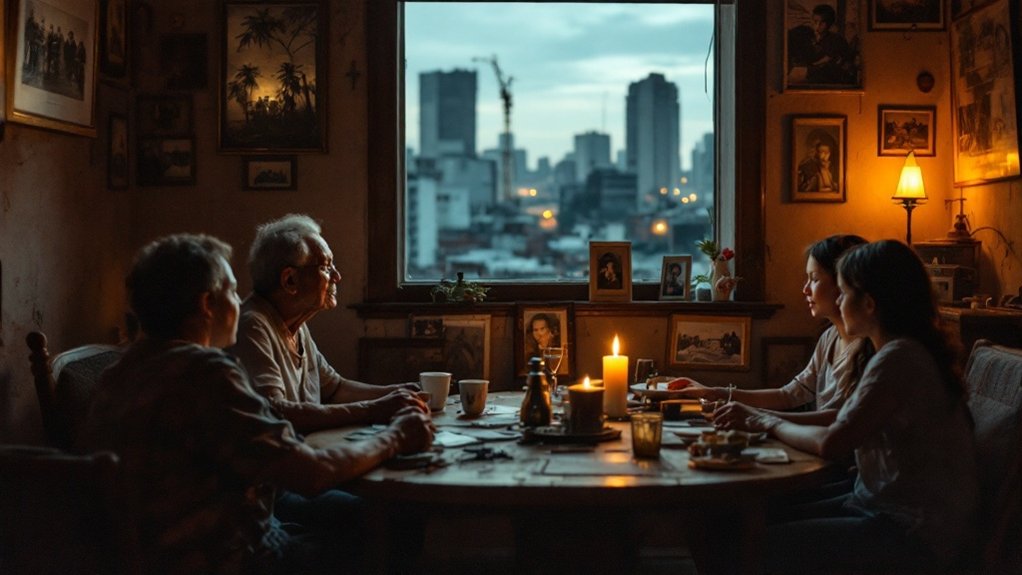
As stories of trauma and fortitude continue to shape Manila’s collective memory, the efforts of survivors to preserve these accounts have become a defining aspect of postwar healing. You’ll find that survivors like Vicky Quirino-Delgado have broken decades of silence, ensuring their legacy endures through documented testimonies.
Organizations such as Memorare-Manila 1945 anchor public remembrance, making the atrocities of the massacre impossible to dismiss. Survivor stories expose the lingering psychological cost, pressing you to recognize how deeply these wounds run through generations.
Education and open dialogue serve as vehicles for reconciliation, helping society confront uncomfortable truths. By engaging with these lessons, you help prevent history’s repetition.
- Survivor testimonies preserve collective memory
- Memorials foster public remembrance
- Trauma’s legacy shapes future generations
- Dialogue supports reconciliation and peace
Frequently Asked Questions
What Actions Did the Philippine War Crimes Commission Take After the Manila Massacre?
After the massacre, you’d see the Philippine War Crimes Commission investigate Japanese atrocities, gather witness testimonies, and prosecute responsible officers. They collaborated with Allied authorities, differentiating from the National War Crimes Office, ensuring justice and accountability for freedom’s sake.
Who Were the Main Japanese Commanders Held Responsible for the Massacre?
You’re asking about accountability, General Tomoyuki Yamashita and Lieutenant General Masaharu Homma were the main Japanese commanders held responsible. Source-based evidence shows Yamashita was executed in 1946, while Homma was linked to atrocities like the Bataan Death March.
How Did the International Community Respond to the Manila Massacre?
When you examine the response, you’ll see the international community condemned the atrocity, prosecuted Japanese commanders in war crimes trials, and publicized the events, but global attention and justice for victims lagged compared to other WWII crimes.
Were Any Japanese Soldiers Prosecuted Specifically for Crimes in Manila?
You’ll find that Japanese officers, including General Yamashita, were prosecuted for war crimes in Manila. Trials relied on the “Yamashita standard,” holding commanders responsible even without direct proof. Source: Philippine War Crimes Commission records, 1945-46.
How Has the Massacre Been Recognized in Modern Philippine Education and Memorials?
You’ll find the massacre addressed in Philippine textbooks and commemorated at sites like the Memorare-Manila 1945 monument. Still, many argue it’s underrepresented, with survivors and advocates pushing for deeper public acknowledgment and curricular integration, citing academic sources.



